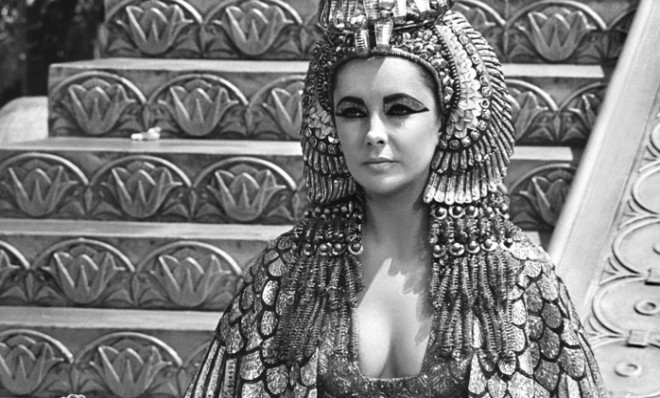Girls on Film: Why it's time for Hollywood to revive the femme fatale
The important and challenging cinematic archetype has fallen out of vogue over the past decade. It's not too late for a comeback


Fifty years ago next week, audiences got their first glimpse of Elizabeth Taylor sitting atop an enormous sphinx as the titular character in 1963's Cleopatra. She was the last pharaoh of ancient Egypt, her political power matched by great beauty and sexual influence.
But the movie was almost eclipsed by its behind-the-scenes scandal; Taylor had stolen Eddie Fisher away from her friend Debbie Reynolds, only to leave him for her new co-star, Richard Burton. In the end, a real-life femme fatale is playing a legendary femme fatale sitting atop yet another: The sphinx, a female-headed lioness who preyed on those who failed to answer her riddles.
Cleopatra's style and subject matter might be from another era, but this image of Taylor as a pharaoh on a sphinx is a potent reminder of the raw power of the femme fatale — something sorely lacking in cinema today.
The Week
Escape your echo chamber. Get the facts behind the news, plus analysis from multiple perspectives.

Sign up for The Week's Free Newsletters
From our morning news briefing to a weekly Good News Newsletter, get the best of The Week delivered directly to your inbox.
From our morning news briefing to a weekly Good News Newsletter, get the best of The Week delivered directly to your inbox.
As described by screenwriter Kim Krizan in Original Sins: Trade Secrets of the Femme Fatale, the deadly woman (or, more commonly, the "femme fatale"), "represents the danger — the ensnaring, seductive, slightly supernatural danger — of female sexuality." She is "the ultimate propaganda tool … intended to prevent women from skipping out on their prescribed role." At the same time, she's a figure of control, "telling her own story and co-opting powerful symbols. She creates her own publicity, circumvents the lousy, constricting roles she doesn't wish to play, commands the attention she desires, and gets what she wants — or has fun trying. A femme fatale is a creature not born, but made."
The femme fatale is actually older than original sin, if you believe in the existence of Adam's first wife, Lilith, described in Jewish folklore. Made not of man, but by the same earth as Adam, she refused to submit, daring to believe she was his equal. She was cast out, inspiring legends of seduction and horrific tales of child slaughter. Eve followed (or was the first, depending on your religious beliefs); she destroyed paradise and was subsequently doomed with painful childbirth and subordination because she dared to desire knowledge.
Taken together, Lilith and Eve create the basis of the femme fatale — a term applied to powerful women to distract society from their authority and frame them as dangerous.
It's an effective facade, and one that disproportionately emphasizes the sexual characteristic of each "fatale." Cleopatra's exotic beauty and many lovers come to mind before anyone considers her impact as a pharaoh. Marie Antoinette is the beautiful queen who dismissed her subjects by saying "Let them eat cake." (Never mind that she never actually said it.) Elizabeth Bathory is remembered as a serial murderer who bathed in blood, though the horrific legends have since been deemed "politically motivated slander." Mata Hari was an exotic dancer and courtesan-turned-spy, but she wasn't really the dangerous vixen pop culture pegs her as; instead, she was a tragic figure struggling to make ends meet in a world where women had few options.
A free daily email with the biggest news stories of the day – and the best features from TheWeek.com
The femme fatale is a complicated archetype, with one foot in sexism and one in feminism. She's a danger who will rip both men and society apart, who fails to submit and yearns to destroy. But she's also the woman who finds control despite stifling power structures, turning the masculinity that marginalizes her into a weapon that empowers her.
The femme fatale is a common figure in classic cinema, particularly film noir — but for all the talk about the dangers and deadliness of the femme fatale in cinema, it's easy to overlook how many femme fatale stories begin with the man taking action.
In Orson Welles' The Lady from Shanghai, Michael stops Elsa's Central Park carriage to meet her and offer her a cigarette. Though she doesn't do a thing to lure him in, she immediately becomes the object of his (self-described) obsession. In Double Indemnity, Walter heads to the Dietrichson house on business, but begins leering and hitting on Phyllis — refusing to stop even when she warns that his flirting is going 45 miles an hour over the speed limit. In The Postman Always Rings Twice, after drifter Frank is quickly taken with the beautiful Cora, he picks up her dropped lipstick not to be chivalrous, but to keep it from her, forcing her to come to him. Even Detour, which sees Vera fiercely manipulate Al, begins with him offering her a ride as she hitchhikes, and getting lost in thoughts about her attractiveness.
Cinema's femme fatales react to how they're treated and what they're offered. Many are unhappy wives or women stuck in subordinate roles they're desperate to leave behind. They use what they have at their disposal — sex appeal, manipulation, mind games — to gain agency in lives that would otherwise be powerless. Their fictional struggle represents the real-life struggle of many actresses of the era; much of classic Hollywood rests on the shoulders of "femme fatales" like Theda Bara, Marlene Dietrich, Rita Hayworth, Barbara Stanwyck, and Lana Turner. They are our visions of classic cinema, figures of immortal lust and empowerment.
The femme fatale lingered through the 1980s and 1990s, when Hollywood replaced implied sexiness with actual sex: Kathleen Turner offered Body Heat, Sharon Stone revealed her Basic Instinct, and Linda Fiorentino got busy with The Last Seduction. But a cinematic culture of extremes was emerging, thrusting the femme fatale out of subtle manipulation and into campy entrapment. Movies like 1998's Wild Things and 1999's Cruel Intentions got bogged down in titillation, and after Brian De Palma's 2002 flop Femme Fatale, the archetype faded away.
And now, it's time for her to return.
Fortunately, some of the world has changed since the archetype's inception — many women no longer have to fight for the right to control their lives. But other things have not. Today's social canvas is screaming for the return of the fierce and iconic femme fatale: Rape culture and a proliferation of public rapist boasting; the fight for sex education and reproductive health; rampant body dysmorphia; international horror stories about acid throwing, gang rape, and genital mutilation. Society is still chock-full of examples that would inspire the femme fatale to fight back.
If the femme fatale returned in full force, cinema could once again defuse the tension between activism and entertainment. The archetype allows a woman's fight for agency to be more than a niche interest marginalized into "women's films," and results in female characters that everyone remembers. She empowers while entertaining; magnetic and engaging, but with a genuinely subversive undercurrent of power that challenges the rigid status quo.
When Rita Hayworth performs her "Put the Blame on Mame" striptease in 1946's Gilda, it's not just a gratuitous throw-in like Alice Eve's underwear shot in Star Trek Into Darkness — though it certainly manages to titillate all the men around her. Gilda is the woman shackled by oppressive male power who takes control of her body back. She looks like an innocent young woman hungry for male attention as she giggles and pulls off her glove, singing about a woman blamed for all manner of destruction — but as the male audience members try to unzip her dress, the smiles disappear and for a glimpse, she looks serious, powerful, and settled. For a moment, she is in charge of how she is treated. She uses the male gaze to gain a moment of control before she's ripped off stage.
Naturally, the femme fatale would need to evolve. She was once the woman struggling for little slices of control in a man's world, often serving as both titillation and a cautionary tale against female power. But while these are aspects of the archetype's long history, the femme fatale is also more powerful than some might expect: A smart figure who finds power where there is little to none, fighting the system from the inside. Her magnetism transcends gender, interests, and culture. She’s the woman who can make taking action fun and alluring again — and not just a frustrating social necessity.
Girls on Film is a weekly column focusing on women and cinema. It can be found at TheWeek.com every Friday morning. And be sure to follow the Girls on Film Twitter feed for additional femme-con.
Monika Bartyzel is a freelance writer and creator of Girls on Film, a weekly look at femme-centric film news and concerns, now appearing at TheWeek.com. Her work has been published on sites including The Atlantic, Movies.com, Moviefone, Collider, and the now-defunct Cinematical, where she was a lead writer and assignment editor.
-
 Farage’s £9m windfall: will it smooth his path to power?
Farage’s £9m windfall: will it smooth his path to power?In Depth The record donation has come amidst rumours of collaboration with the Conservatives and allegations of racism in Farage's school days
-
 The issue dividing Israel: ultra-Orthodox draft dodgers
The issue dividing Israel: ultra-Orthodox draft dodgersIn the Spotlight A new bill has solidified the community’s ‘draft evasion’ stance, with this issue becoming the country’s ‘greatest internal security threat’
-
 Codeword: December 13, 2025
Codeword: December 13, 2025The daily codeword puzzle from The Week
